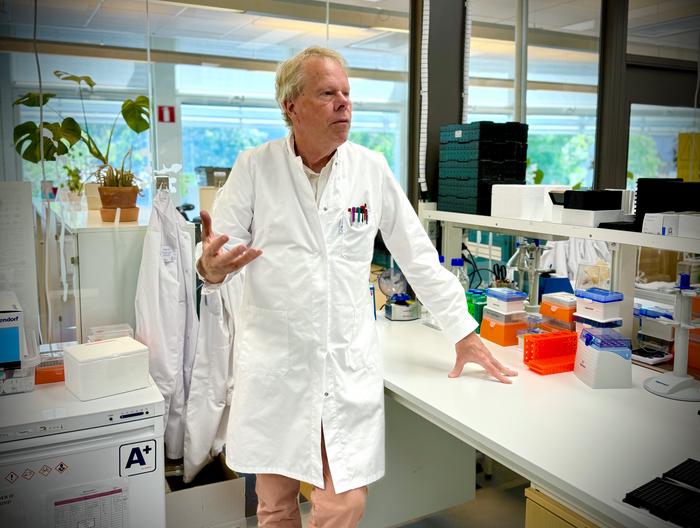Pan-disease blood atlas reveals molecular fingerprints of 59 conditions
An international research team has mapped distinct molecular “fingerprints” in blood proteins across 59 diseases, creating a comprehensive resource that could revolutionise how clinicians distinguish between different conditions and identify early warning signs of illness.

“We can separate universal false alarm bells of inflammation from truly disease specific signals,” says Mathias Uhlén, professor at Stockholm’s KTH Royal Institute of Technology and the director of the Human Protein Atlas project.
The Human Disease Blood Atlas, published in Science on 9 October 2025, analysed blood samples from 8,262 individuals, profiling up to 5,416 proteins to reveal how diseases leave unique signatures in the circulating proteome. The study represents one of the most extensive pan-disease proteomics efforts to date.
Distinguishing disease signals from inflammatory noise
Traditional biomarker discovery has typically compared individual diseases against healthy controls – an approach that often produces markers lacking specificity for real-world clinical use. The new atlas addresses this limitation by comparing diseases side-by-side, revealing which protein changes are truly disease-specific versus those reflecting general inflammation.
“By comparing these diseases side by side, we can separate universal false alarm bells of inflammation from truly disease specific signals,” says Mathias Uhlén, professor at Stockholm’s KTH Royal Institute of Technology and director of the Human Protein Atlas project.
The researchers found that many proteins elevated in cancer or autoimmune conditions also rise during infections, reflecting shared inflammatory pathways rather than disease-specific changes. For example, fibroblast growth factor 1 (FGF1) appeared highly specific for pancreatic cancer when compared only to healthy individuals, but lost this specificity when bacterial infections were included in the comparison.

María Bueno Álvez, first author of the study.
Tracking protein changes from childhood to adulthood
The study included two longitudinal cohorts tracking healthy individuals over time. A wellness cohort of 96 adults aged 50-65 were followed for two years, whilst 100 children from the BAMSE birth cohort were assessed at ages 4, 8, 16 and 24 years.
These longitudinal analyses confirmed that each individual possesses a unique, stable blood protein profile over time. The childhood cohort revealed dramatic proteome shifts during puberty, with many proteins reaching adult-like concentrations by age 16.
Specific sex-related changes emerged during adolescence. Three proteins – insulin-like 3 (INSL3), epididymal secretory protein E3-beta (EDDM3B) and serine peptidase inhibitor Kunitz-type 3 (SPINT3) – showed similar concentrations in boys and girls at ages 4 and 8, but increased dramatically in males during puberty, reflecting their expression in the male reproductive system.
Machine learning identifies age-related protein signatures
Using machine learning approaches, the team developed models predicting biological age from blood protein profiles with high accuracy (R² = 0.85 using 200 proteins). The models identified proteins that change predictably with age, such as chemokine CXCL17, which gradually increases throughout life, and type IX collagen component COL9A1, which decreases sharply during puberty.
“Every day, around 70 new biomarker studies are published worldwide, but most compare disease against controls,” says María Bueno Álvez, first author and PhD student at KTH. “Because many proteins show variability across multiple conditions, such narrow comparisons often produce results that cannot be reproduced, contributing to the wider reproducibility crisis in today’s science.”
The age prediction models showed substantial overlap with proteins identified in previous large-scale studies, including work from the UK Biobank, validating the robustness of these age-related signatures.
Disease-specific versus shared protein patterns
The pan-disease analysis revealed both unique and shared proteomics signatures across conditions. Liver-related diseases and infectious diseases showed particularly high overlap in their protein profiles, whilst paediatric systemic inflammatory conditions displayed distinct patterns characterised by generally lower plasma protein abundances.
Machine learning models achieved varying performance depending on the disease and comparison group. Classification worked well for conditions with distinct protein signatures, such as lung cancer and ovarian cancer, whilst breast and prostate cancers proved more challenging to distinguish.
Validating cancer biomarkers for early detection
For five major cancers – breast, lung, colorectal, prostate and ovarian – the researchers expanded their analysis to nearly 2,000 samples using a more comprehensive protein panel targeting over 5,400 proteins. They then tested whether identified biomarkers could detect cancer before diagnosis by analysing UK Biobank samples from over 50,000 individuals.
The results showed promise particularly for lung cancer, with area under the curve (AUC) values around 0.7 even years before diagnosis. Ovarian cancer showed strong performance only at diagnosis, whilst prostate cancer models did not demonstrate predictive capability in the pre-diagnostic setting.
Specific proteins showed temporal dynamics relating to diagnosis. For lung cancer, CEACAM5 levels increased as individuals approached diagnosis. For ovarian cancer, WFDC2 demonstrated similar patterns.
Addressing limitations and future directions
The researchers acknowledge several limitations, including the narrow demographic region (predominantly Sweden, Turkey, Italy, Belgium, Denmark and Norway) and reliance on a single assay platform. Sample collection across multiple biobanks may have introduced variability, and the proteomics platform cannot detect all blood proteins due to the extreme dynamic range of the human blood proteome.
“The mapping of molecular fingerprints of disease is a crucial step for building blood tests that work in the clinic,” says Uhlén.
The study also notes that whilst their machine learning models identified proteins associated with diseases and demographic factors, the current pipeline may overestimate predicted performance. The primary aim was exploratory – identifying proteomics features with potential diagnostic relevance rather than building clinically deployable models.
- The Human Disease Blood Atlas is available online at proteinatlas.org/humanproteome/blood , allowing researchers worldwide to explore protein profiles across the 59 diseases and identify candidate biomarkers for further validation studies.
Reference
Álvez, M. B., Bergström, S., Kenrick, J., et. al. (2025). A human pan-disease blood atlas of the circulating proteome. Science, 10.1126/science.adx2678. https://doi.org/10.1126/science.adx2678

